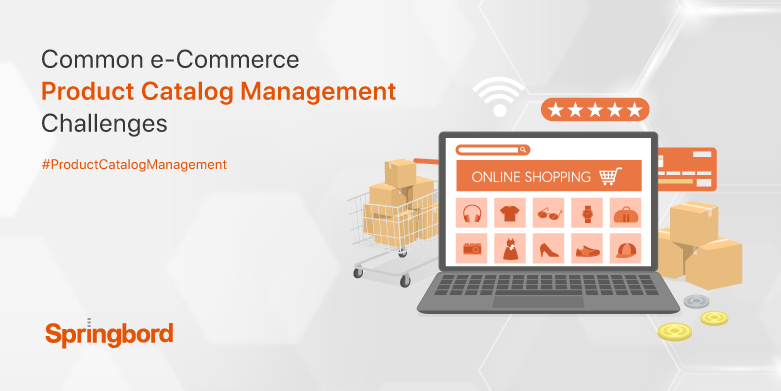 Read time 8 min
Read time 8 minE-commerce product information management (PIM) plays a pivotal role in the success of online businesses. In the extremely competitive e-commerce landscape, effective product information management is essential. E-commerce product information management requires collecting, organizing, enriching, and distributing product data across multiple channels.
With e-commerce PIM, businesses can ensure the accuracy and consistency of product listings, enhance the customer experience, and boost operational efficiency.
This article will examine the fundamentals of e-commerce product information management, including its significance and the challenges it addresses in the ever-changing world of online retail.
Key Components of E-commerce PIM
E-commerce product information management (PIM) comprises several key components enabling businesses to manage and showcase their product data effectively.
The whole product data lifecycle is covered here, from data gathering and structuring to content enhancement and distribution. For a successful e-commerce PIM implementation, an awareness of these factors is crucial.
- Product Data Collection and Organization: Collecting and organizing product data is the first step toward a successful product information management system for online stores. For this, information such as product names, descriptions, SKUs, prices, and stock levels must be gathered.
The information is then organized and labeled for straightforward maintenance and retrieval. Consistency can be maintained, and product data may be efficiently searched and filtered using standardized data models and taxonomies.
Enterprises commonly use centralized product data management systems to streamline data gathering and organization.
These databases are data warehouses where information about products is stored and managed. Businesses now have a single location to collect, update, and disseminate product information.
- Product Data Enrichment: Product data enrichment involves enhancing basic product information with additional attributes, specifications, and media assets. This is an important stage in giving prospective buyers all the information they need to decide.
Enhancing product descriptions entails including relevant products or accessories and adding technical information, high-quality photos, videos, and other media assets.
By allowing shoppers to make educated purchases, effective product data enrichment enhances the shopping experience for everyone involved. It also helps with SEO because it’s easier to rank highly for specific terms when more information is provided about a product.
- Product Data Syndication: Distributing product data across many sales channels and platforms is essential for online retailers to attract a large customer base. You can increase your sales by efficiently distributing product data to various sales channels, such as online marketplaces, social media sites, and comparison shopping engines.
Syndicating product data is a great way for companies to ensure their products are listed accurately and consistently across all sales channels.
This procedure includes adapting the data format, automating the syndication process, and mapping product features to each channel’s requirements. Companies may expand their customer base, boost revenue, and solidify their online identity by mastering the art of syndication.
- Data Governance and Quality Control: E-commerce PIM relies heavily on the accuracy and reliability of the data it stores. Good data governance guarantees product details are correct, current, and consistent with norms.
Establishing procedures, guidelines, and roles for handling product data is what we mean when discussing “data governance.”
Errors, inconsistencies, or gaps in product data can be remedied with quality control procedures like data validation rules. Data audits and cleansing are regular operations that help ensure data quality and integrity.
- Integration with E-commerce Systems: For optimal data flow and smooth operations, PIM must be seamlessly integrated with other e-commerce systems, such as online storefronts, content management, and inventory management systems.
When many systems are integrated, product data is automatically updated in real time, eliminating the possibility of inconsistencies and duplications.
Product information, such as prices and stock levels, can be updated automatically thanks to integration. It simplifies operations, reduces the need for physical labor, and boosts productivity.
Benefits of E-commerce PIM
E-commerce product information management (PIM) offers numerous benefits to businesses operating in the online retail space. By implementing an effective PIM system, businesses can unlock the following advantages:
- Improved Product Data Quality: E-commerce product information management (PIM) raises the bar by guaranteeing that product information is correct, comprehensive, and consistent.
Businesses may need to be more consistent with handling product data across numerous systems or spreadsheets by centralizing product information and enforcing standardized data standards.
Businesses can save time and money by avoiding consumer returns and complaints thanks to more accurate and complete product data. Since search engines place a premium on relevant and precise information, having high-quality product data also boosts organic search rankings.
- Enhanced Customer Experience: E-commerce PIM is crucial in ensuring customers have a positive experience with your business. Businesses may equip their clients to make wise purchases by giving them access to detailed, informative product descriptions.
Customers are more likely to be satisfied with a purchase after carefully considering the information provided in the product description, photos, videos, and technical specs. Furthermore, firms may increase consumer loyalty and repeat purchases with consistent and accurate product data across all sales channels.
- Increased Operational Efficiency: E-commerce product information management (PIM) increases productivity by simplifying managing product information.
Data entry, enrichment, and syndication are many business tasks that may be automated and simplified with a PIM system. Because of this automation, less time is spent doing repetitive tasks by hand, and humans make fewer mistakes.
PIM can be integrated with other e-commerce systems, such as inventory or content management, to facilitate real-time data synchronization and updating. This integration ensures that all systems use the most recent product information and removes the need for manual data transfers.
Businesses may better manage resources and concentrate on growth-driving strategies by streamlining processes and eliminating wasteful activities.
- Streamlined Product Launches and Updates: E-commerce product information management (PIM) streamlines the introduction of new products and the revision of current ones. Having everything for a product listing in one place makes it much simpler for businesses to generate and manage them.
This makes adding new products to the catalog easier and guarantees that all required information is supplied uniformly. In addition, businesses can make the necessary upgrades and changes to current products directly in the PIM system, and those updates will then be propagated to all associated sales channels.
This saves time and reduces the possibility of inconsistent or out-of-date information by eliminating the need for manual changes across multiple platforms. By streamlining the introduction of new products and the rollout of upgrades, companies can meet the needs of consumers more quickly.
Challenges in Implementing E-commerce PIM
While e-commerce product information management (PIM) offers significant benefits, its implementation can present certain challenges that businesses must address. Understanding and overcoming these challenges is crucial for successfully adopting and utilizing an e-commerce PIM system.
- Data Complexity and Scalability: Managing the complexity and scalability of data presents a significant obstacle to e-commerce PIM deployment. Online retailers often stock a wide variety of products, each with unique specifications, customization options, and media assets.
It can take time to keep up with the ever-changing details of many products, especially as the company expands. Systems for PIM need to be able to process massive amounts of data without slowing down.
The need to manage parent-child relationships and cross-sell links among data elements makes the data model more complicated. As a result, businesses need to assess and choose PIM systems that can manage the complexity and scope of their data as their catalog grows.
- Data Integration with Existing Systems: E-commerce PIM integration with pre-existing systems like inventory management, content management, or customer relationship management (CRM) can be difficult.
Data interchange and synchronization between these systems might be difficult since they may use different data structures and formats. Integrating two or more systems needs precise mapping of data fields, the creation of data flows, and the verification of system compatibility.
Inconsistencies in data mapping, incompatibilities between systems, and the current state of technology all provide potential problems. To overcome these obstacles, IT teams and vendors must frequently collaborate to create individualized integration solutions.
- Data Governance and Quality Control: There is always room for improvement in data governance and quality management in e-commerce PIM. Product data management, upkeep, and governance are all aspects of data governance.
Defining data standards, workflows, and ownership can ensure organizational consistency and accuracy. Maintaining accurate product details requires putting in place procedures to ensure data quality, such as data validation rules or automatic data cleansing.
Continuous monitoring, regular data audits, and timely attention to data discrepancies or errors are essential for efficient data governance and quality management.
- User Adoption and Training: The success of an e-commerce PIM system heavily relies on user adoption and training. There may be pushback from staff members who are used to the old way of doing things when introducing a new system and workflow.
The success of a PIM system depends on user adoption, and adoption requires proper training and change management tactics. The best practices for managing product data and how to use the system’s capability should be covered in training.
Overcoming the barrier to user acceptance requires user-friendly interfaces, thorough documentation, and continuing assistance and advice.
Best Practices for Ecommerce PIM Implementation
Implementing e-commerce product information management (PIM) requires careful planning and execution to ensure a successful and efficient system. By following best practices, businesses can maximize the benefits of their PIM implementation and overcome potential challenges.
- Defining Clear Data Standards and Workflows: Consistent and effective administration of product information relies on the definition of defined data standards and workflows. Standard data fields, properties, and formats must be defined to guarantee uniformity throughout an organization’s whole product catalog.
Among these are standards for product names, descriptions, characteristics, and media files. Data workflows assist in streamlining product data administration and ensure that the right stakeholders are involved at each stage, including data entry, validation, enrichment, and approval.
- Selecting the Right PIM Software or Solution: A successful implementation relies heavily on selecting suitable PIM software or solution. Scalability, adaptability, integration options, and ease of use are just a few of the criteria businesses should consider while making this determination.
Evaluation of the PIM system’s data complexity-handling capabilities, multi-channel syndication capability, and depth of features for data enrichment and governance are all essential.
Selecting a PIM solution that fits the company’s objectives and long-term goals can be aided by conducting extensive research, speaking with providers, and reading user evaluations.
- Integrating PIM with Other E-commerce Systems: When maximizing data flow and keeping everything in sync, nothing is more important than ensuring that your product information management (PIM) system is seamlessly integrated with your other e-commerce systems.
Integrating systems allows for instantaneous changes, synced data, and streamlined processes. Businesses should consider API compatibility, mapping, and real-time data transfer capabilities when deciding how to integrate PIM with existing systems.
If you work with IT teams or hire integration professionals, you can ensure everything goes smoothly.
- Establishing Data Governance Processes: Implementing solid processes is crucial for preserving data quality and integrity. Data governance includes establishing data validation criteria and setting procedures to monitor data quality.
To ensure that only authorized individuals have access to and may make changes to product data, it is crucial to design data governance regulations such as data access controls, change management processes, and version control.
Data integrity and conformance to standards can be maintained via regular reviews and updates to data governance processes.
- Regularly Auditing and Maintaining Product Data Quality: Successful implementation of a product information management system (PIM) for online retail requires constant monitoring and updating of product data. Inconsistencies, inaccuracies, or outdated data can be found and corrected using regular data audits.
Data quality control metrics and cleansing actions must be established and implemented, such as removing duplicate or stale items. The accuracy and freshness of the product catalog rely on the regular evaluation and update of data, including prices, descriptions, and photographs.
Automated processes and quality control technologies can reduce the time and effort spent on data upkeep.
To Sum Up
Effective e-commerce product information management (PIM) is fundamental to the success of online enterprises. In light of the complexities and difficulties involved in managing product data, it is essential to collaborate with a dependable and seasoned service provider.
Here is where Springbord comes into play. Springbord has over 20 years of experience as a prominent provider of high-quality labeling services to businesses in various industries. Their specialized data labeling services are tailored to each client’s requirements, ensuring product information’s accuracy and value.
In addition, Springboard can provide insightful information about customers and their actions, enhancing your e-commerce operations.







